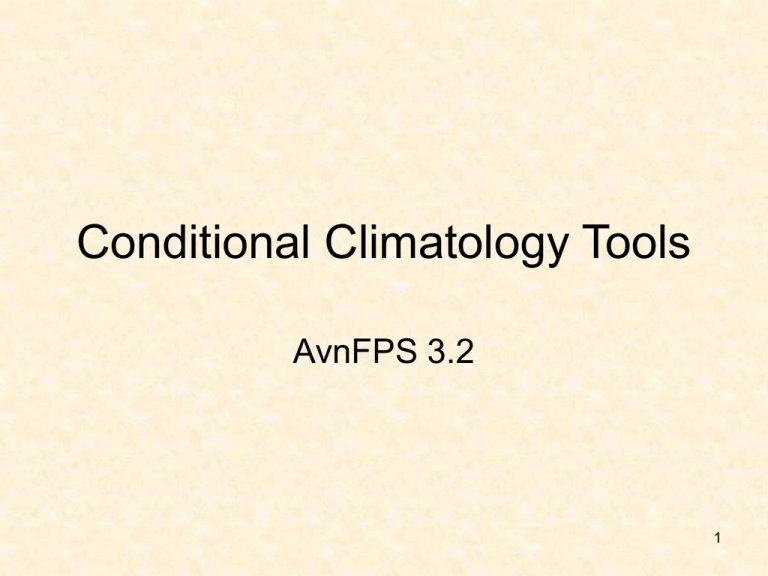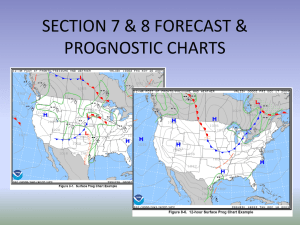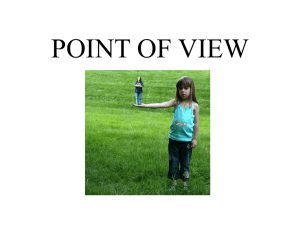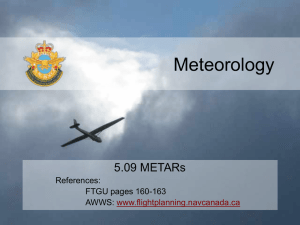Conditional Climatology
advertisement

Conditional Climatology Tools AvnFPS 3.2 1 Contributors 2 Contributors • • • • • • • Mike Graf (NWS Headquarters) Jerry Griffin (NWS Training Center) David Hotz (WFO Morristown, TN) Todd Lericos (WFO Caribou) Cammye Sims (WFO San Antonio) Mark Struthworf (WFO Salt Lake City) Jeff Tongue (WFO New York City) 3 Objectives • Describe Conditional Climatology – Definition – Benefits/Limitations • Discuss new AvnFPS 3.2 climatology tools – Wind Rose – CIG/VSBY Distributions – CIG/VSBY Trends • Discuss current forecast methods/limitations • Adding Conditional Climatology to the Forecast Toolkit • Interpret and apply the output – Case studies – Local case studies 4 What is Conditional Climatology? • A distribution of variables now and in the future based on one or more given conditions. • Examples: – Pattern Recognition – Conceptual Models – Local Rules of Thumb – Forecaster Experience 5 Role of Conditional Climatology in Aviation Forecasting • 1960’s – Conditional Climatology Tables - USAF • 1970’s to present – Numerical models – MOS • 2000’s – Integration of CC back into the aviation forecast process 6 Benefits of Conditional Climatology? • Guidance on event duration, intensity and trends • Limits over forecasting of rare events • Increases forecaster confidence • Better results than just using persistence forecasting or NWP/MOS guidance 7 Limitations of Conditional Climatology • Can not be used alone! • Does not discriminate physical processes • May not be useful in extreme or rare weather events • Not fool proof 8 Wind Rose Tool 9 Applied Wind Rose 10 CIG/VSBY Distribution Tool 11 Why are we here? 12 Why are we here? 13 Why are we here? SOO Intern Lead General 14 Why are we here? The SOO is killing me with all this Training SOO Intern Lead General 15 CIG/VSBY Trend Tool 16 How Do You Forecast Ceiling Height and Visibility???? 17 How Do You Forecast Ceiling Height and Visibility???? 18 How Do You Forecast Ceiling Height and Visibility???? 19 How Do You Forecast Ceiling Height and Visibility???? 20 How Do You Forecast Ceiling Height and Visibility???? 21 How Do You Forecast Ceiling Height and Visibility???? 22 What Tools Do you Use? 23 What Tools Do you Use? • • • • • • • • • Current Observations Satellite MOS Soundings / BUFKIT Model Data Local Studies Advection Convection Persistence 24 What Tools Do you Use? • • • • • • • • • Current Observations Satellite MOS Soundings / BUFKIT Model Data Local Studies Advection Convection Persistence 25 Using NWP Model Data to forecast clouds 26 Models • Relative Humidity??? • Model Clouds??? 27 Model Soundings? 28 BUFKIT – RH and Clouds 29 Relative Humidity = Clouds? 30 Adding “Model” Clouds 31 RH with respect to ICE or Water? RH With Respect to Water RH With Respect to Ice 32 RH Time Section 33 Model Clouds and Bases 34 How good are NWP Models at predicting: • Moisture? • It’s Horizontal and Vertical Distribution? • Cloud Ceilings? 35 Model Output Statistics! • Good idea. • Removes biases. • Adds Climatology. 36 MAV MOS • Is the “Weather” in Caribou the same as State College PA or New York City? Is the Weather in Atlanta the same as San Antonio? • Regional Equations are used for Ceiling and Visibility 37 Summer (Apr-Sept) Winter (Oct-Mar) 38 MAV MOS • Model “Run time” plus 3 Hour Observation is Critical (03Z, 09Z, 15Z or 21Z) • Use the Ceiling and Visibility Category Probabilities. 39 MOS - Ceiling and Visibility Category Probabilities. 40 NGM MOS • Look at NGM Synoptic Pattern • Period of Record used for equation Development is Extensive • 02Z and 14Z Observations are critical 41 We need more • Rules of thumb? • “in this situation, the cloud base “usually” remains IFR until late morning.” • CLIMATOLOGY!!! • “Conditional” Climatology 42 Example 18Z TAF John F. Kennedy International Airport 43 44 45 46 17Z METAR • METAR KJFK 311651Z 14009KT 10SM BKN007 BKN250 19/16 A3020 RMK AO2 SLP226 T01940161 47 Situation • SE Flow Prevails • When and How Low does the Ceiling and Visibility Go?? 48 12Z NAM-eta (Fcst Hr = 05) Valid 17Z 49 15Z RUC (Fcst Hr = 02) Valid 17Z 50 12Z NAM-eta (Fcst Hr = 14) Valid 02Z 51 15Z RUC (Fcst Hr = 11) Valid 02Z 52 GFS MOS 53 NGM MOS 54 Current TAF • KJFK 311509Z 311512 14009KT P6SM BKN007 TEMPO 1617 SCT007 • FM1700 14009KT P6SM SCT010 SCT080 SCT140 • FM0200 VRB04KT 1SM BR SCT004 SCT040 • FM0600 VRB03KT 3/4SM BR BKN004 TEMPO 0811 1/2SM FG VV002= 55 Joint Distribution • • • • • (default) May-Jun 16-18Z SE Wind 600-1000’ Un-restricted Visibility 56 Ceiling Distribution • • • • • (default) May-Jun 16-18Z SE Wind 600-1000’ Un-restricted Visibility 57 Visibility Distribution • • • • • (default) May-Jun 16-18Z SE Wind 600-1000’ Un-restricted Visibility 58 Ceiling Distribution • • • • • Apr-mid Jun 13-22Z S-E Wind 500-900’ Un-restricted Visibility 59 Visibility Distribution • • • • • Apr-mid Jun 13-22Z S-E Wind 500-900’ Un-restricted Visibility 60 What Would You Forecast? 61 What Was Forecast? • • • • • • • • • • FTUS41 KOKX 311700 TAFJFK TAF KJFK 311728Z 311818 14009KT P6SM BKN007 TEMPO 1923 SCT007 FM0200 14006KT 3SM BR BKN005 FM0600 VRB03KT 1SM BR OVC004 TEMPO 0811 1/2SM FG VV002 FM1400 18005KT 5SM HZ BKN008 FM1700 21009KT P6SM SCT010 SCT050= 62 TAF based on Climatology? TAF KJFK 311728Z 311818 14010KT P6SM BKN007 FM2200 14008KT 3SM BR OVC004 FM0000 14008KT 1/2SM FG VV002 …… ACTUAL TAF (no CC) • • • • • • • KJFK 311728Z 311818 14009KT P6SM BKN007 TEMPO 1923 SCT007 FM0200 14006KT 3SM BR BKN005 FM0600 VRB03KT 1SM BR OVC004 TEMPO 0811 1/2SM FG VV002 FM1400 18005KT 5SM HZ BKN008 FM1700 21009KT P6SM SCT010 SCT050= 63 KJFK 311751Z 15007KT 10SM BKN007 19/16 A3020 RMK AO2 SLP225 T01890161 10194 20172 56004= KJFK 311851Z 15007KT 10SM VCFG BKN007 19/16 A3019 RMK AO2 SLP222 VIS S 2 1/2 T01890161= KJFK 311951Z 15009KT 8SM BKN007 19/16 A3017 RMK AO2 SLP217 T01890161= KJFK 312051Z 16011KT 8SM OVC007 18/16 A3016 RMK AO2 SLP213 T01830156 58013= KJFK 312151Z 15011KT 1/2SM BR OVC005 18/16 A3013 RMK AO2 SFC VIS 6 SLP203 T01780161= KJFK 312155Z 15011KT 1/8SM BR OVC003 18/16 A3013 RMK AO2 SFC VIS 6= KJFK 312214Z 15011KT 1/2SM BR OVC003 17/16 A3013 RMK AO2 SFC VIS 6 SFC VIS E-SE 2 1/2 $= KJFK 312251Z 15007KT 1/2SM R04R/3500VP6000FT BR OVC003 17/16 A3014 RMK AO2 SFC VIS 1 1/2 SLP204 T01720161= KJFK 312351Z 15009KT 1/2SM R04R/2000V3500FT BR OVC003 17/16 A3014 RMK AO2 SFC VIS 3/4 SLP204 T01670161 10194 20167 56008= KJFK 010051Z 15006KT 1/2SM R04R/2200V3500FT BR OVC003 17/16 A3013 RMK AO2 SFC VIS 3/4 SLP203 T01670161= KJFK 010151Z 19009KT 1/4SM R04R/2000V2800FT FG VV002 17/16 A3014 RMK AO2 SFC VIS 1/2 SLP205 T01670161 $= KJFK 010232Z 18005KT 1/4SM R04R/1800V2200FT FG VV002 17/16 A3014 RMK AO2 SFC VIS 1/2 $= KJFK 010238Z 19006KT 1/8SM R04R/2000V2200FT FG VV002 17/16 A3013 RMK AO2 SFC VIS 1/4 $= KJFK 010251Z 18007KT 1/8SM R04R/2200V2600FT FG VV002 17/16 A3013 RMK AO2 SFC VIS 1/2 SLP203 T01670161 58001 $= KJFK 010324Z 17007KT 0SM R04R/1600V1800FT FG VV001 17/16 A3013 RMK AO2 SFC VIS 1/4 $= KJFK 010351Z 18007KT 0SM R04R/1400V1600FT FG VV001 17/17 A3013 RMK AO2 SFC VIS 1/4 SLP201 T01670167 $= KJFK 010451Z 17005KT 0SM R04R/1600V2000FT -DZ FG VV001 17/17 A3013 RMK AO2 SFC VIS 1/8 DZB35 SLP203 P0000 T01720167 401940167 $= KJFK 010551Z 14006KT 0SM R04R/1600FT FG VV001 17/17 A3012 RMK AO2 SFC VIS 1/4 DZE50 SLP199 P0000 60000 T01720167 10172 20167 58005 $= KJFK 010651Z 15005KT 0SM R04R/1200V1400FT FG VV001 17/17 A3010 RMK AO2 SFC VIS 1/8 SLP193 T01720167 $= KJFK 010751Z 18005KT 0SM R04R/1400FT FG VV001 17/17 A3008 RMK AO2 SFC VIS 1/8 SLP187 T01720167 $= KJFK 010851Z 18007KT 0SM R04R/2200V2600FT FG VV001 17/17 A3007 RMK AO2 SFC VIS 1/2 SLP182 T01720167 56017 $= KJFK 010911Z 17007KT 0SM R04R/1600V2000FT FG VV001 17/17 A3007 RMK AO2 SFC VIS 1/4 $= KJFK 010925Z 18007KT 0SM R04R/2000V3500FT FG VV001 17/17 A3007 RMK AO2 SFC VIS 1/4 $= KJFK 010951Z 20007KT 0SM R04R/2200V2600FT FG VV002 17/17 A3007 RMK AO2 SFC VIS 1/2 SLP182 T01720167 $= KJFK 011005Z 20006KT 0SM R04R/1800V2000FT FG VV002 17/17 A3007 RMK AO2 SFC VIS 1/4 $= KJFK 011014Z 21006KT 0SM R04R/1800V2000FT FG VV001 18/17 A3007 RMK AO2 SFC VIS 1/4 $= KJFK 011051Z 21004KT 0SM R04R/1400FT FG VV001 18/17 A3007 RMK AO2 SFC VIS 1/4 SLP183 T01780172 $= KJFK 011151Z 22006KT 0SM R04R/1000FT FG VV001 18/18 A3006 RMK AO2 SFC VIS 1/8 SLP180 T01830178 10183 20167 58002 $= 64 KJFK 011251Z 20005KT 0SM R04R/1000V2000FT FG VV001 19/18 A3006 RMK AO2 SFC VIS 1/4 SLP179 T01890183= KJFK 011303Z 19006KT 0SM R04R/1400V2400FT FG VV001 19/18 A3006 RMK AO2 SFC VIS 1/4= KJFK 011340Z 21007KT 0SM R04R/2000V5500FT BR OVC002 19/18 A3005 RMK AO2 SFC VIS 3/4= Best times to use Conditional Climatology • During “steady state” quiet weather situations. • Fog/Stratus events – Radiation Fog – Advection Fog – Marine Stratus • Prevailing Wind • Determining Onset and Dissipation Times. • Seasonal Refresher and New Forecasters orientation. • New TAF sites, where 30-years of data exists 65 What You Need to Do • Develop local Case Studies with your Airports and TAFs to learn how best to integrate the NEW tools into your TAF’s and your forecast operations. 66 Summary • Conditional Climatology improves the TAF process through increased forecaster confidence. • Must correctly integrate Conditional Climatology with Observations, NWP, MOS and other techniques. • Conditional Climatology can improve TAF quality and service. 67 AVNFPS 3.2 Web Pages • Main Page: http://www.nws.noaa.gov/mdl/pgb/AvnFPS/3.2/AvnFPS3.2.html • Supplemental Instructions: http://www.nws.noaa.gov/mdl/pgb/AvnFPS/3.2/CS-DH-3.2.doc 68 Pre-View - AVNFPS 3.3 69 Pre-View AVNFPS 3.3 70 Pre-View AVNFPS 3.3 71 Thank You! 72 References • BUFKIT: http://www.wdtb.noaa.gov/tools/BUFKIT/ • MOS: http://www.nws.noaa.gov/mdl/synop/products.shtml • MODCV: https://notus2.afccc.af.mil/ • MODELS: http://www.emc.ncep.noaa.gov/ 73 References • Old Forecast Tools (Ouija Board, Crystal Ball, Dart Board and the “Magic” 8 Ball) available at Wal-Mart, Target and other fine stores! 74








